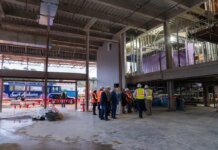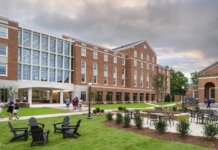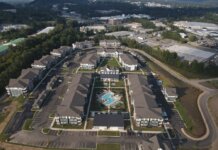
As the height of the COVID-19 pandemic recedes further into the rearview mirror, employees are slowly but steadily leaving home and returning to the office. In doing so, however, they still want to enjoy a feeling of home.
According to a Gallup poll conducted in August of employees who have worked from home part time, the number of days spent working remotely each month has declined 35% since 2020 — though it remains 25% more than in 2019. And increasingly, the offices they are returning to do not look or feel the same as before.
This is an intentional change on the part of many employers and commercial real estate agents looking to repair an office market that was damaged by the pandemic. People will be more willing to leave home for the office, the thinking goes, if the office reminds them of home.
“If you’d rather be working from home because it’s comfortable and well-adorned, bringing a little bit of that to the workspace makes it more of a homey experience,” says James McCormick, director of construction development at New York-based D&A Companies, which recently completed the redevelopment of the 2222 Arlington office building on Birmingham’s Southside. “Having things like hardwood floors, curtains, a nice kitchen and dining area, takes the cubicle corporate stigma out of coming to the office.”
Or as broker Tommy Gleason, of CRE Mobile, says, “It may look more like your living room, with couches and chairs where you can sit around and talk, than just a bland institutional office with a sea of cubicles.”
Overall, offices have been moving away from the structured cubicle approach for decades, spurred by the tech firms of Silicon Valley with their foosball tables and yoga rooms. This trend has only accelerated since the COVID-19 pandemic.

“Folks really want to incorporate light and a sense of the outdoors into an office building,” says D&A co-founder Evan Watts, a native of Atlanta who has family in Birmingham. “They’re asking for a blend of private space and flexible communal workspace. We’re helping tenants envision these spaces in a way that was not commonplace just a few years ago.”
Watts says the 55,000-square-foot building at 2222 Arlington is a good example of the changes taking place within the CRE world. Constructed in 1976, the building’s former design was “labyrinthian,” Watts says, with limited natural light and “cubicle after cubicle after cubicle.”

One of the first things D&A did was create a second lobby on the opposite side of the original one, then divide the remaining space into sections, mostly between 5,000 and 10,000 square feet each. “Tenants are looking for less space,” Watts says, “but they’re willing to spend almost the same amount every month in order to have more amenities.”
Those amenities vary greatly, though almost all are designed to enhance employee comfort and enjoyment while at work. For example, McCormick says the building’s anchor tenant — Atlas Senior Living — asked for an expansive recreation and entertainment area that can be used by individual employees but also for large corporate events such as a college basketball March Madness watch party. Meanwhile, McCormick says the law firm Marsh, Rickard & Bryan requested a lounge area that looks and feels like an upscale coffee shop.
“It’s an aspect that they wanted in order to break up having it feel like a traditional office,” McCormick says. “None of our tenants were interested in a spec office space. Instead, they wanted to bring these other spaces that people enjoy into the office.”
Gleason says he is seeing similar requests from prospective tenants in Mobile for such in-office amenities as fitness centers and game rooms. In particular, he says, there is an emphasis on improving employee lounge areas, since simply gathering around the water cooler or coffeemaker no longer is considered an acceptable way for employees to take a break.

“The biggest problem with working from home is you don’t have the collaboration that comes from just being around your fellow workers,” Gleason says. “So, lounge areas where people can sit and relax but also collaborate are popular. That’s something we’ll probably be doing more often in the future.”
Tenant requests are extending beyond the office walls as well. The numerous indoor restrictions that were introduced during COVID placed an emphasis on access to safe and enjoyable outdoor spaces, and the desire for such spaces did not go away once the indoor restrictions were lifted. So outside beauty is now considered by many to be an office amenity.
“We want to encourage people to walk out of the (2222 Arlington) building,” Watts says. “We’ve invested a lot into the landscaping and the hardscaping. We have these plazas in front and a garden in back. Spaces where people can just enjoy themselves.”
But it’s not all fun and games. Some of the requested amenities have a practical purpose. Home maintenance tech company Shipshape wanted a room filled with video screens on the wall (“Like a NASA command center,” McCormick says), and Gresham Smith architects asked for multiple Zoom rooms equipped specifically to handle conference calls.
McCormick says Gresham Smith also has embraced a concept call hot-desking, in which employees do not have an assigned desk. Instead, they simply choose any available desk when they arrive each day.
It is an approach that has long been used in the Navy, where sailors will share a bunk on a rotating basis when each one is off duty. McCormick says the idea is the same in the modern office now that many employees work from home several days each week.

“If you have 50 employees, but only 25 or 30 are ever in the office at one time, there’s no need to have 50 desks,” McCormick says. “This way, you can have a smaller office space.”
Gleason also has witnessed a shift toward office downsizing. He says after the COVID pandemic began, CRE Mobile “went more than a year without signing a single new office lease.” While the situation has improved significantly this year, he says much of the leasing has been for smaller spaces.
“We’ve had to take some larger vacancies, divide up the space, and then add some of these (amenities),” Gleason says. “That seems to be working. Because once we make those changes, the spaces lease pretty quickly.”
After all, while there may be no place exactly like home, the office is becoming a little bit closer.
Cary Estes is a Birmingham-based freelance contributor to Business Alabama.
This article appears in the November 2023 issue of Business Alabama.



